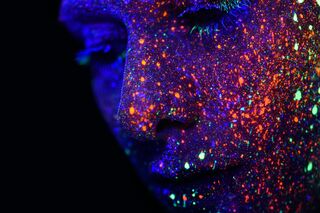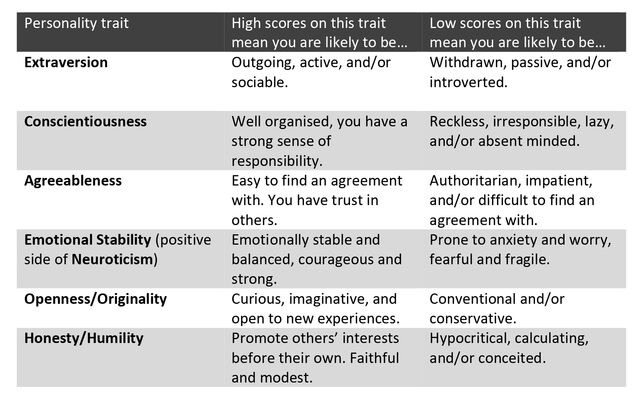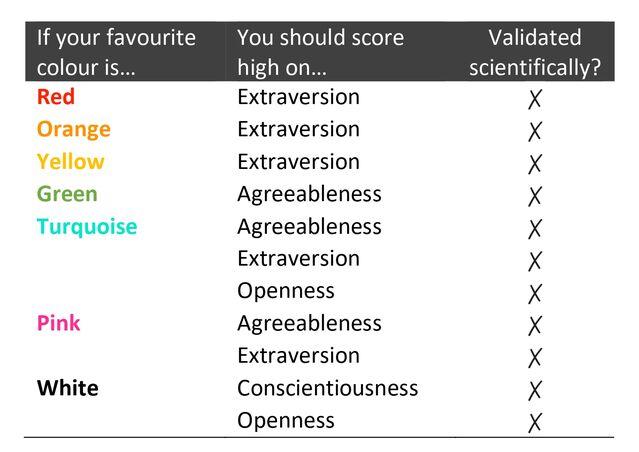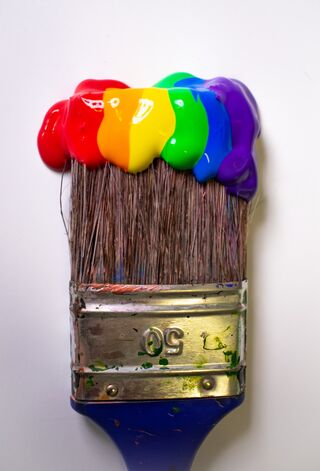Personality
Does Your Favorite Color Tell People Something About Who You Are?
Lovers of red really may not really be more extroverted.
Posted January 12, 2022 Reviewed by Gary Drevitch

For millennia, people have attempted to discover hidden character traits via seemingly unrelated characteristics—one’s handwriting, a bump on the skull, or the arrangement of the stars and planets on the say of one's birth. Being experimental colour psychologists, we were most interested in the notion that colour preferences could also do the job. Basically, the idea goes that people can be “deciphered” through which colour they like the most. The person can then learn something about themselves, or another person, by simply indicating what their favourite colour is.
Notably, researchers tested, and clever entrepreneurs promoted, various instruments linking colour choices and personal characteristics. Research discredited the validity of many such instruments (e.g., Ault & Barney, 2007). Yet, instead of falling into disuse, some turned into profitable enterprises. Completing such personality tests in a magazine or on a website seems playful and entertaining, but really, think about it: Should their results dictate what you and others think of yourselves? Imagine that results from such a colour-personality test fed into your professional profile, determining whether you are judged able (or not) to take on particular tasks. You would certainly wish this test to be trustworthy and of valuable predictability of your abilities and performance.
Recently, we went back to the drawing board asking whether there is any scientific evidence that favourite colours link to people’s personalities (Jonauskaite et al., 2021). The available scientific literature had neither been very rich nor elusive. We had to conclude that the devil is in the detail, because it was not obvious how to study such a question scientifically. The relatively simple part was the colour choice: We could ask people to tell us which colour they like the most. When it came to deciphering character traits, it got trickier.
On some popular websites, you might read that those who love red are “extraverted and optimistic, confident and courageous”, “fiery and energetic”, or have a “strong personality”. You can also read that those who love blue are “conservative, reliable and trustworthy” or are “the meditative type … good at keeping calm and level-headed”. While these descriptions are vivid and engaging, they are also very broad and vague. It is thus a challenge to match such popular descriptions of personal characteristics to validated means used in scientific research.
Personal characteristics are frequently assessed using self-report personality questionnaires, which have been developed and validated over years of research. Here, participants are asked to evaluate their identification with a list of personal descriptions. The most widely known personality model considers that every person can be represented through a combination of five major personality traits (recently, extended to six). These personality traits are listed and briefly described in Table 1.

Considering these traits, we had to link formulations of popular colour-personality relationships to descriptions of these validated personality models. If we take again the example of red, those who like this colour are described as extraverted, optimistic, confident, courageous, fiery, energetic, and having a strong personality. This description evokes a relatively clear idea of personal characteristics, but if we inspect the actual adjectives, we recognise only one that refers to a personality trait (extraverted). Now, any researcher would face a challenge to match these terms from popular descriptions to personality traits. We took on this challenge using a lexical analysis. We first extracted the adjectives from popular websites. Then, we compared these adjectives to validated lists of adjectives that describe scientifically validated personality traits (for examples, see here, formerly published in Ashton & Lee, 2007; Saucier, 2009). This way, we could figure out which adjectives in popular descriptions are referring to validated personality traits. To return to our example of red, we found out that the adjective extraverted indeed matched high Extraversion, while courageous matched high Resilience, and fiery matched low Agreeableness. The adjectives optimistic and confident did not appear in the lists.
For our actual study, we used six different web pages that described colour-personality relationships in three languages. The above example on red was taken from one of these sites. From another site, we extracted additional keywords for red: driven, determined, likes to take risks, outgoing, assertive, and impulsive. Outgoing was the only adjective that corresponded to the validated lists, indicating high Extraversion. Thus, we now had two websites that assumed that people who like red are extraverted. After systematically following this procedure for all websites and colour terms, we could compile a list of 11 colour-personality relationships that were widely shared (see Table 2 for all the predicted and tested relationships). Our goal was now to validate that these colour-personality relationships hold true empirically.

We did so by having 341 people tell us their favourite colour and complete a validated personality questionnaire. Then, we grouped participants according to their favourite colour. For instance, we grouped them into those who favour red and those who favour another colour. We then compared Extraversion scores between these two groups. We found that people whose favourite colour was red were equally high (or low) on Extraversion compared to the remaining participants. We performed respective comparisons for the remaining 10 colour-relationship predictions. None was confirmed.
Based on these results, we conclude that personal characteristics as assessed via personality traits are not encoded in colour preferences.

Those who wish to question our results and their generalizability might say that different results would be obtained if people actually look at colours or if other personality models are considered. Results might also be different if the study was performed on non-students. There is surely space for such questioning and suggestions for future studies. Until different empirical evidence has been presented, however, it seems worthwhile leaving colour personality tests to game nights and conversation starters. Their “insights” into who you and other people are should be taken cautiously and with a grain of salt. If something sounds like it could apply to anyone, it probably does. By being too general, too positive, and too optimistic, such descriptions fail to discriminate between (groups of) people. And for these reasons, they offer little true insight into other people’s characters.
Facebook image: Yellowj/Shutterstock
LinkedIn image: Juan_Algar/Shutterstock
References
Ashton, M. C., & Lee, K. (2007). Empirical, Theoretical, and Practical Advantages of the HEXACO Model of Personality Structure. Personality and Social Psychology Review, 11(2), 150–166. https://doi.org/10.1177/1088868306294907
Ault, J. T., & Barney, S. T. (2007). Construct validity and reliability of Hartman’s Color Code Personality Profile: Information exchange article. International Journal of Selection and Assessment, 15(1), 72–81. https://doi.org/10.1111/j.1468-2389.2007.00369.x
Jonauskaite, D., Thalmayer, A. G., Müller, L., & Mohr, C. (2021). What does your favourite colour say about your personality? Not much. Personality Science, 2, e6297. https://doi.org/10.5964/ps.6297
Saucier, G. (2009). Recurrent personality dimensions in inclusive lexical studies: Indications for a Big Six Structure. Journal of Personality, 77(5), 1577–1614. https://doi.org/10.1111/j.1467-6494.2009.00593.x




